
INTRODUCTION TO THE BREED STANDARD
In the earliest days of man’s relationship with dogs, he began to see that those particular dogs constructed in a certain way were better suited to performing a particular task. Particular characteristics were prized and breeding practices were employed to perpetuate these characteristics.
The people who kept these dogs gathered to make comparisons and seek out stock to improve their own lines. The more successful keepers were asked to observe the dogs at work and evaluate them.
With urbanization, fewer and fewer dogs were given the opportunity to perform their intended functions. To avoid the respective breeds’ losing their ability to perform, the fanciers began to select their stock based on the conformation that they determined would produce the most successful workers. The guidelines or “standards” became theoretical rather than practical.
Previously, the accent had been on function; now it was on form. It should be easy to see, once form was the keynote, how breeds whose only purpose was to be esthetically pleasing would gain an equal place of respect alongside their working-breed counterparts.
It should be noted here that these early breed descriptions were the forerunners of breed standards and that they were written by knowledgeable individuals in each breed for their peers. These experts were all thoroughly familiar with their respective breeds. Their descriptions were used primarily as checklists or blueprints to breed by, and they served as reminders so that important and defining points of the breed’s conformation and character would not be lost.
Today’s standards describe the ideal specimen of a breed. They are written by individuals versed in breed type and canine anatomy. They include descriptions of structure, temperament, coat, color and the manner in which the dog moves. The standards are used by breeders to assist them in breeding toward this goal of perfection. While no dog is absolutely perfect, the dogs that adhere closest to the ideal are what breeders will determine to be show or breeding stock. The dogs that deviate too far from the ideal are considered as companion or pet stock.
The standard is also used by dog-show judges to compare actual dogs to the ideal. The dog that the judge feels adheres closest to the ideal is the winner of the class, and so on down the line as the classes progress to Best in Show.
THE AMERICAN KENNEL CLUB STANDARD FOR THE TOY FOX TERRIER
History: The Toy Fox Terrier is a true American breed developed by breeding small Smooth Fox Terriers with several toy breeds including the Chihuahua and Manchester Terrier. Today, the Toy Fox Terrier is a well-balanced toy dog of athletic appearance, displaying grace and agility in equal measure with strength and stamina. From the hunt to the show ring, the Toy Fox Terrier has become a cherished companion dog and excellent show piece. The Toy Fox Terrier has shown that he is at home in conformation, obedience and agility trials, his favorite spotlight is the center stage of his owner’s life.
BREEDER’S BLUEPRINT
If you are considering breeding your bitch, it is very important that you are familiar with the breed standard. Reputable breeders breed with the intention of producing dogs that are as close as possible to the standard and that contribute to the advancement of the breed. Study the standard for both physical appearance and temperament, and make certain that your bitch and your chosen stud dog measure up.

The standard describes the breed’s correct body structure as well as the desired temperament, which should be friendly and eager to please, as this Toy Fox demonstrates to the judge!
The Toy Fox Terrier is a toy and a terrier, and both have influenced his personality and character. While retaining the terrier gameness, courage and animation, the cross-breeding with various toy breeds mentioned created a milder disposition. Although easier to live with than many terriers, the Toy Fox Terrier is still a working terrier, and many of them delight in hunting and going to ground. Given the opportunity, the Toy Fox Terrier will pursue the quarry of the backyard or barnyard with diligence. Known to tree squirrels and flush out rodents, the hunt is always welcome. Flyball or fetch are easily learned and perfected for endless hours of activity. However, if you enjoy a lap dog, this little companion appears to know the latest in television entertainment of his household. Children especially enjoy the unending energy and zeal for play throughout this dog’s life.
MEETING THE IDEAL
The American Kennel Club defines a standard as: “A description of the ideal dog of each recognized breed, to serve as an ideal against which dogs are judged at shows.” This blueprint is drawn up by the breed’s recognized parent club, approved by a majority of its membership, and then submitted to the AKC for approval. Some countries handle standards differently; in England, for example, all standards and changes are controlled by The Kennel Club.
The AKC states that “An understanding of any breed must begin with its standard. This applies to all dogs, not just those intended for showing.” The picture that the standard draws of the dog’s type, gait, temperament and structure is the guiding image used by breeders as they plan their programs.
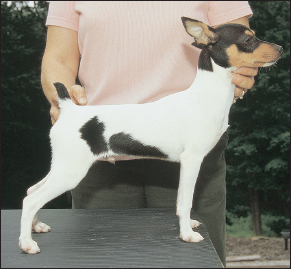
General Appearance: The Toy Fox Terrier is truly a toy and a terrier and both have influenced his personality and character. As a terrier, the Toy Fox Terrier possesses keen intelligence, courage, and animation. As a toy he is diminutive and devoted with an endless abiding love for his master. The Toy Fox Terrier is a well-balanced toy dog of athletic appearance displaying grace and agility in equal measure with strength and stamina. His lithe muscular body has a smooth elegant outline which conveys the impression of effortless movement and endless endurance. He is naturally well groomed, proud, animated and alert. Characteristic traits are his elegant head, his short glossy and predominantly white coat, coupled with a predominantly solid head, and his short high-set tail.
Size, Proportion and Substance: Size: 8.5–11.5 inches, 9–11 preferred, 8.5–11.5 acceptable. Proportion: The Toy Fox Terrier is square in proportion, with height being approximately equal to length; with height measured from withers to ground and length measured from point of shoulder to buttocks. Slightly longer in bitches is acceptable. Substance: Bone must be strong, but not excessive and always in proportion to size. Overall balance is important. Disqualification: Any dog under 8.5 inches and over 11.5 inches.

A Toy Fox Terrier of correct type, substance, structure and balance in profile.
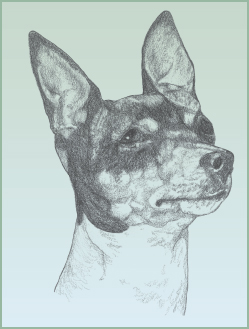
A Toy Fox Terrier head study showing a dog with correct markings, structure, type and proportion.
Head: The head is elegant, balanced and expressive with no indication of coarseness. Expression is intelligent, alert, eager and full of interest. Eyes: Clear, bright and dark, including eye-rims, with the exception of chocolates whose eye-rims should be self-colored. The eyes are full, round and somewhat prominent, yet never bulging, with a soft intelligent expression. They are set well apart, not slanted, and fit well together into the sockets. Ears: The ears are erect, pointed, inverted V-shaped, set high and close together, but never touching. The size is in proportion to the head and body. Disqualification: Ears not erect on any dog over six months of age. Skull: Moderate in width, slightly rounded and softly wedge shaped. Medium stop, somewhat sloping. When viewed from the front, the head widens gradually from the nose to the base of the ears. The distance from the nose to the stop is equal to the distance from the stop to the occiput. The cheeks are flat and muscular, with the area below the eyes well filled in. Faults: Apple head. Muzzle: Strong rather than fine, in proportion to the head as a whole and parallel to the top of the skull. Nose: Black only with the exception of self-colored in chocolate dogs. Disqualification: Dudley nose. Lips: Small and tight fitting. Bite: A full complement of strong white teeth meeting in a scissors bite is preferred. Loss of teeth should not be faulted as long as the bite can be determined as correct. Disqualification: Undershot, wry mouth, overshot more than one-eighth inch.
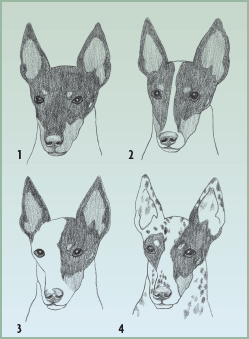
1 & 2: Dogs showing solid color without (1) and with (2) blaze, with ears and eyes fully marked. Both are correct. 3 & 4: A split faced dog (3) is incorrect. The ears being predominantly white with heavy ticking (4) is also incorrect.
Neck, Topline and Body: The neck is carried proudly erect, well set on, slightly arched, gracefully curved, clean, muscular and free from throatiness. It is proportioned to the head and body and widens gradually blending smoothly into the shoulders. The length of the neck is approximately the same as that of the head. The topline is level when standing and gaiting. The body is balanced and tapers slightly from ribs to flank. The chest is deep and muscular with well sprung ribs. Depth of chest extends to the point of elbow. The back is straight, level, and muscular. Short and strong in loin with moderate tuck-up to denote grace and elegance. The croup is level with topline and well-rounded. The tail is set high, held erect and in proportion to the size of the dog. Docked to the third or fourth joint.
Forequarters: Forequarters are well angulated. The shoulder is firmly set and has adequate muscle, but is not overdeveloped. The shoulders are sloping and well laid back, blending smoothly from neck to back. The forechest is well developed. The elbows are close and perpendicular to the body. The legs are parallel and straight to the pasterns which are strong and straight while remaining flexible. Feet are small and oval, pointing forward turning neither in nor out. Toes are strong, well-arched and closely knit with deep pads.
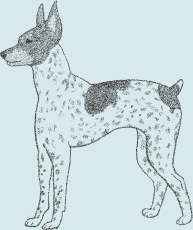
Faults: Incorrect heavy body ticking, upright shoulders, roached back, weak rear, cow-hocked and steep in croup.
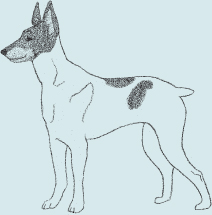
Faults: Ewe neck, loaded shoulders, wide front with toeing out, low tail set, weak rear and steep in croup.
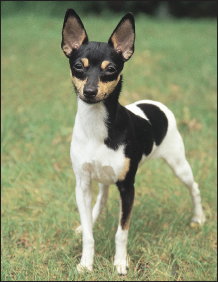
The desired forequarters should be well angulated, with shoulders firmly set, sloping and well laid back. Front legs are parellel and straight.

The hindquarters are strong, well angulated, with clearly defined stifles and firm hock joints, well let down. From the rear, the legs are straight and parallel.
Hindquarters: Hindquarters are well angulated, strong and muscular. The upper and lower thighs are strong, well muscled and of good length. The stifles are clearly defined and well angulated. Hock joints are well let down and firm. The rear pasterns are straight. The legs are parallel from the rear and turn neither in nor out. Dewclaws should be removed from hindquarters if present.
Coat: The coat is shiny, satiny, fine in texture and smooth to the touch. It is slightly longer in the ruff, uniformly covering the body.
Color: Tri-color: Predominately black head with sharply defined tan markings on cheeks, lips and eye dots. Body is over 50% white, with or without black body spots. White, Chocolate and Tan: Predominately chocolate head with sharply defined tan markings on cheeks, lips and eye dots. Body is over 50% white, with or without chocolate body spots. White and Tan: Predominately tan head. Body is over 50% white, with or without tan body spots. White and Black: Predominately black head. Body is over 50% white with or without black body spots. Color should be rich and clear. Blazes are acceptable, but may not touch the eyes or ears. Clear white is preferred, but a small amount of ticking is not to be penalized. Faults: Color, other than ticking, that extends below the elbow or the hock. Disqualifications: A blaze extending into the eyes or ears. Any color combination not stated above. Any dog whose head is more than 50% white. Any dog whose body is not more than 50% white. Any dog whose head and body spots are of different colors.
Gait: Movement is smooth and flowing with good reach and strong drive. The topline should remain straight and head and tail carriage erect while gaiting. Fault: Hackney gait.
Temperament: The Toy Fox Terrier is intelligent, alert and friendly, and loyal to his owners. He learns new tasks quickly, is eager to please, and adapts to almost any situation. The Toy Fox Terrier, like other terriers, is self-possessed, spirited, determined and not easily intimidated. He is a highly animated toy dog that is comical, entertaining and playful all of his life. Any individuals lacking good terrier attitude and personality are to be faulted.
Disqualifications
Any dog under 8.5 inches or over 11.5 inches.
Ears not erect on any dog over six months of age.
Dudley nose.
Undershot, wry mouth, overshot more than one-eighth inch.
A blaze extending into the eye or ears.
Any color combination not stated above.
Any dog whose head is more than 50% white.
Any dog whose body is not more than 50% white.
Any dog whose head and body are of different colors.
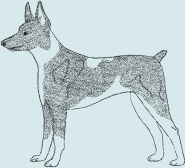
Faults: Excessive body markings (more than 50%), long backed, low tail set, straight in rear and upright shoulders.
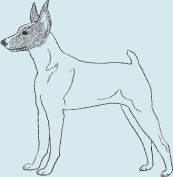
Faults: Short neck, upright loaded shoulders, gay tail, straight in rear, shallow chest and lacking tuck-up.
Approved: July 11, 2000
Effective: April 1, 2001